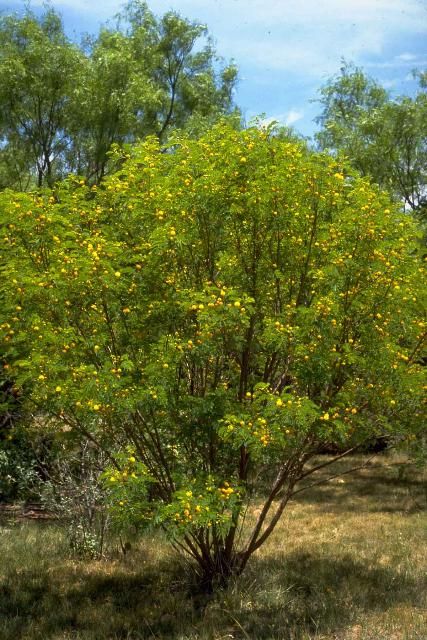Introduction
Goldenball Leadtree is a native North American evergreen tree which reaches 25 feet in height and has blue/green to bright green foliage. The showy, yellow to white, rounded blooms appear from April to October and are especially prominent after a heavy rain. The attractive fruits which follow ripen in late summer.

Credit: Ed Gilman
General Information
Scientific name: Leucaena retusa
Pronunciation: loo-KAY-nuh ree-TOO-suh
Common name(s): Goldenball Leadtree, Littleleaf Leucaena, Littleleaf Leadtree
Family: Leguminosae
USDA hardiness zones: 7A through 9B (Fig. 2)
Origin: native to North America
Invasive potential: weedy native
Uses: deck or patio; specimen; highway median; Bonsai
Availability: not native to North America

Description
Height: 20 to 25 feet
Spread: 15 to 25 feet
Crown uniformity: irregular
Crown shape: vase, upright/erect
Crown density: open
Growth rate: moderate
Texture: fine
Foliage
Leaf arrangement: alternate (Fig. 3)
Leaf type: bipinnately compound
Leaf margin: entire
Leaf shape: oblong, elliptic (oval)
Leaf venation: pinnate
Leaf type and persistence: evergreen
Leaf blade length: less than 2 inches
Leaf color: green
Fall color: no color change
Fall characteristic: not showy
Flower
Flower color: yellow
Flower characteristics: very showy
Fruit
Fruit shape: pod or pod-like, elongated
Fruit length: 1 to 3 inches, 3 to 6 inches
Fruit covering: dry or hard
Fruit color: brown
Fruit characteristics: does not attract wildlife; showy; fruit/leaves a litter problem
Trunk and Branches
Trunk/bark/branches: branches droop; showy; typically multi-trunked; thorns
Pruning requirement: needed for strong structure
Breakage: susceptible to breakage
Current year twig color: brown
Current year twig thickness: thin
Wood specific gravity: unknown
Culture
Light requirement: full sun
Soil tolerances: clay; sand; loam; alkaline; acidic; well-drained
Drought tolerance: high
Aerosol salt tolerance: unknown
Other
Roots: not a problem
Winter interest: no
Outstanding tree: yes
Ozone sensitivity: unknown
Verticillium wilt susceptibility: unknown
Pest resistance: unknown
Use and Management
The crown can develop a one-sided or asymmetrical habit when it is young, so pruning and training may be needed to form a more uniformly shaped crown. The drooping habit of the branches makes it difficult to maintain near a street, but it would make a nice accent tree for the shrub border or backyard garden. The tree tends to seed itself into the surrounding landscape and spreads rapidly. Some consider it a weed, and the wood is brittle.
Goldenball Leadtree should be grown in full sun on well-drained soil and will tolerate alkaline conditions very well. Care must be taken in the placement of this tree in the landscape since the wood is susceptible to breakage in wind- and ice-storms. Plant it in a spot protected from the wind.
Propagation is by seed.
Pests and Diseases
No pests or diseases are of major concern.